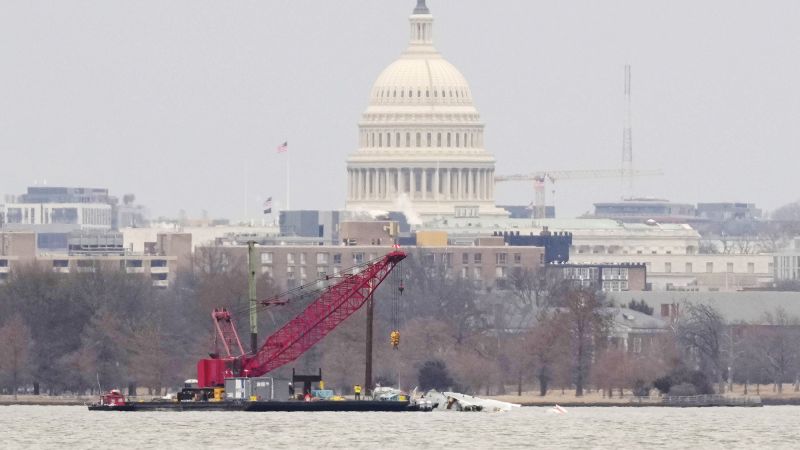Recovery of DC jet wreckage begins as investigators review new information – CNN

Just offshore from the towering national monuments of Washington, a tall crane now hovers over the Potomac River. It casts a large shadow over the ongoing effort to understand what caused the collision of a passenger jet and a military helicopter last Wednesday, as a new phase of the recovery started Monday.
Crews have begun removing large parts of the wreckage of American Airlines Flight 5342, the regional jet whose fuselage came to rest upside-down in three pieces after running directly into an Army Black Hawk helicopter, taking the lives of everyone aboard both aircraft. It’s the deadliest US aviation disaster in more than 20 years.
Monday’s work was painstaking and slow. A jet engine was the first piece of debris to emerge from the frigid water, slowly raised by the crane. Video taken from shore showed salvage workers guiding it gently to the deck of a barge. From a distance, most of the engine’s cowling and exhaust nozzle appeared intact.
It took another two hours before a second piece of the plane was pulled out – a jagged portion of the fuselage that was not immediately identifiable.
Here’s the latest on the recovery operations and the investigation into the cause:
The salvage work began after divers spent the weekend getting a view of what people on the surface cannot see – the full extent of the underwater debris field – developing a plan to recover the jet wreckage they believe will take the rest of the week. Pulling out the wreck of the helicopter is scheduled to take another four days.
Related article
Investigation into DC plane and helicopter collision looking at potential mistakes in ‘no margin for error’ situation
But the US Army Corps of Engineers – which is managing the recovery operation – says the exact timeline cannot be certain because not all victims have been identified. If more human remains are found during the wreckage removal, they will pause.
“The dignified recovery of missing flight passengers and personnel takes precedence,” Col. Francis Pera, commander of the Corps’ Baltimore District, said Sunday.
The remains of 55 of the 67 victims have been identified, according to a news briefing Monday. Those victims included 28 athletes, coaches and family members associated with US Figure Skating. Many of them were participants in the national championships in Wichita and a development camp which followed, the organization said.
The NTSB said Monday the agency is working to get the airplane – a Bombardier CRJ700 regional jet – out first, before the helicopter, a Sikorsky UH-60 Black Hawk.
The bodies of the victims yet to be recovered are believed to be within the wreckage of the two aircraft, according to Gary Steen, DC Fire and EMS assistant fire chief.
Steen said the divers working through the recovery process are dealing with “everything imaginable that you can think of … day in and day out.”
Recovery crews began their work under clear skies but have been working in water hovering around just 36 degrees. By Wednesday, inclement weather is forecast to return to Washington, with a possibility of rain and sleet.
Pera said Monday’s recovery efforts were successful.
“Throughout the day we’ve had some success. The first of the two engines was removed at about 10 o’clock this morning,” Pera said, adding the fuselage was pulled about two hours later and a wing at about 2:30 p.m.
Officials said they are on pace to recover jet’s cockpit Tuesday, wind gusts and tidal levels permitting.
The first sign the pilot of one of the aircraft may have seen the other before the collision came to light over the weekend: The National Transportation Safety Board says the jet’s flight data recorder has an indication the plane’s nose came up just before the disaster.
Related article
Inside the grueling effort to recover the bodies of all 67 victims from the mangled wreckage of DC plane collision
“At one point very close to the impact, there was a slight change in pitch, an increase in pitch,” NTSB member Todd Inman said at a Saturday evening news conference.
A key question in the investigation is whether the Black Hawk helicopter was higher than the 200-foot altitude limit it was supposed to observe as it flew a designed route along the eastern bank of the Potomac.
Inman said the Bombardier jet’s flight data recorder gives an altitude reading of about 325 feet at the time of impact, but air traffic controllers never had an indication the helicopter went above 200 feet.
The NTSB recovered the so-called black box of the Black Hawk helicopter, the agency said Sunday. Board chairperson Jennifer Homendy told CNN on Monday information was recovered from the flight data recorder.
“They have gotten information, downloads from that (black box),” said Homendy, “and now they’re taking that data and making sure that it’s accurate, that the time stamps are right to try to marry it up with the (black box) data from the plane in order to provide that information publicly.”
The black box is critical, Homendy said, because the DC tower radar does not provide a constant readout of aircraft altitude, updating only every five seconds.
“There’s a lot that occurs in five seconds, especially when a helicopter is moving at a pretty good clip,” she said.
Later Monday, the NTSB said the flight data recorder for the Black Hawk did not have timestamps.
“Investigators will have to manually create timestamps, which requires additional time to validate,” the release said.
NTSB releases photos from the Jan. 29 Bombardier CRJ700 and Sikorsky UH-60 Black Hawk mid-air collision on the Potomac River near Reagan National Airport: https://t.co/YAj2MO2tXA pic.twitter.com/BLVf0N7ASE
“The issue is going to become did the readout come from the helicopter? Was it tower equipment that misinterpreted?” said CNN transportation analyst Mary Schiavo, former inspector general at the Department of Transportation.
If the radar gave air traffic controllers bad readings, Schiavo said, investigators will want to look at maintenance records.
“The air traffic controllers don’t repair that tower equipment,” Schiavo told CNN’s John Berman. “That is handled by contractors, and so now we’re looking at another group of people. Who was repairing that tower equipment?”
A preliminary report from the NTSB is likely to still be a month away. Homendy says her entire agency was given an exemption to the Trump administration’s blanket offer to most federal employees of what it described as a “buyout.” She told CNN keeping their staffing level is critical to producing a timely report.
“We have expert investigators,” Homendy said. “I don’t think a lot of people realize that we only have 436 employees for all modes of transportation, and so we are very small, and we do run lean, for example, our structural engineers. We only have two structural engineers in the entire agency for aviation, and there’s not a lot of backup.”
The altitude of the helicopter is still a key question to be answered, Transportation Secretary Sean Duffy told CNN’s “State of the Union” on Sunday, but there are others, as well.
Related article
A ‘bright star’ helicopter pilot, a daughter of immigrants and figure skating champions are among DC air collision victims
“Were the pilots of the Black Hawk wearing night vision goggles? Did it affect their peripheral vision or perception?” he said.
“What was happening inside the (air traffic control) tower?” Duffy added. “Were they understaffed?”
On the night of the crash, a single controller was handling approach traffic for both planes and helicopters, an air traffic control source told CNN.
Normally those jobs are performed by two people, although the source and the air traffic controllers’ union said it was not uncommon for those duties to be combined.
Even as evidence continues to be collected from tapes and pulled from the water, the former director of the FAA’s Office of Accident Investigation says he’s confident the cause of the disaster will be unambiguous.
“We have radar data, we have eyewitnesses and we have all the wreckage,” Steven Wallace told CNN’s Phil Mattingly. “There’s nothing missing.”
Andy Rose wrote this story from Atlanta, with reporting from Pete Muntean in Washington, DC. CNN’s Zoe Sottile, Michelle Watson, Gabe Cohen and CNN Meteorologist Robert Shackleford contributed to this report.
© 2025 Cable News Network. A Warner Bros. Discovery Company. All Rights Reserved. CNN Sans ™ & © 2016 Cable News Network.
Source: https://www.cnn.com/2025/02/03/us/washington-dc-plane-crash-recovery/index.html






